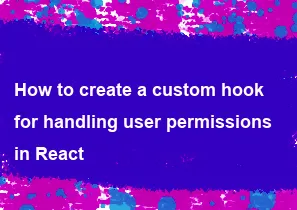How to create a custom hook for handling user permissions in React

Creating a custom hook for handling user permissions in React can be quite useful for managing authorization logic across your application. Below is a basic example of how you can create such a custom hook:
jsximport { useState, useEffect } from 'react';
const usePermissions = () => {
const [permissions, setPermissions] = useState([]);
// Simulated API call to fetch user permissions
useEffect(() => {
const fetchPermissions = async () => {
try {
// Replace this with your actual API call to fetch permissions
const response = await fetch('/api/user/permissions');
if (response.ok) {
const data = await response.json();
setPermissions(data.permissions);
} else {
throw new Error('Failed to fetch user permissions');
}
} catch (error) {
console.error('Error fetching user permissions:', error);
}
};
fetchPermissions();
// Clean-up function
return () => {
// Cleanup logic if needed
};
}, []);
// Function to check if a user has a specific permission
const hasPermission = (requiredPermission) => {
return permissions.includes(requiredPermission);
};
return { permissions, hasPermission };
};
export default usePermissions;
In this custom hook:
usePermissions: This is the main function of the hook. It initializes thepermissionsstate usinguseState. It also fetches user permissions from an API usinguseEffect. You should replace the API call with your actual logic to fetch permissions.hasPermission: This is a helper function returned by the hook. It takes arequiredPermissionas an argument and checks if the user has that permission.
Here's how you can use this custom hook in your components:
jsximport React from 'react';
import usePermissions from './usePermissions';
const MyComponent = () => {
const { permissions, hasPermission } = usePermissions();
// Example usage of permissions
const isAdmin = hasPermission('admin');
return (
<div>
{isAdmin ? (
<div>You have admin privileges</div>
) : (
<div>You do not have admin privileges</div>
)}
</div>
);
};
export default MyComponent;import React from 'react';
import usePermissions from './usePermissions';
const MyComponent = () => {
const { permissions, hasPermission } = usePermissions();
// Example usage of permissions
const isAdmin = hasPermission('admin');
return (
<div>
{isAdmin ? (
<div>You have admin privileges</div>
) : (
<div>You do not have admin privileges</div>
)}
</div>
);
};
export default MyComponent;
By using this custom hook, you can easily manage user permissions throughout your React application. Ensure that you handle loading states and errors appropriately in your components, especially during the permissions fetching process.
-
Popular Post
- How to optimize for Google's About This Result feature for local businesses
- How to implement multi-language support in an Express.js application
- How to handle and optimize for changes in mobile search behavior
- How to handle CORS in a Node.js application
- How to use Vue.js with a UI framework (e.g., Vuetify, Element UI)
- How to configure Laravel Telescope for monitoring and profiling API requests
- How to create a command-line tool using the Commander.js library in Node.js
- How to implement code splitting in a React.js application
- How to use the AWS SDK for Node.js to interact with various AWS services
- How to use the Node.js Stream API for efficient data processing
- How to implement a cookie parser middleware in Node.js
- How to implement WebSockets for real-time communication in React
-
Latest Post
- How to implement a dynamic form with dynamic field styling based on user input in Next.js
- How to create a custom hook for handling user interactions with the browser's device motion in Next.js
- How to create a custom hook for handling user interactions with the browser's battery status in Next.js
- How to implement a dynamic form with dynamic field visibility based on user input in Next.js
- How to implement a dynamic form with real-time collaboration features in Next.js
- How to create a custom hook for handling user interactions with the browser's media devices in Next.js
- How to use the useSWRInfinite hook for paginating data with a custom loading indicator in Next.js
- How to create a custom hook for handling user interactions with the browser's network status in Next.js
- How to create a custom hook for handling user interactions with the browser's location in Next.js
- How to implement a dynamic form with multi-language support in Next.js
- How to create a custom hook for handling user interactions with the browser's ambient light sensor in Next.js
- How to use the useHover hook for creating interactive image zoom effects in Next.js